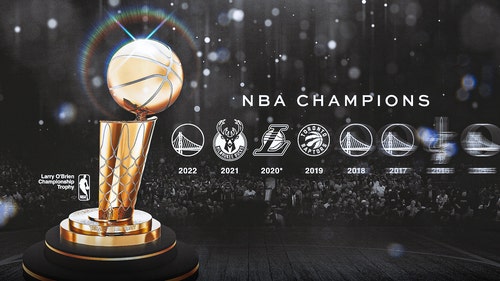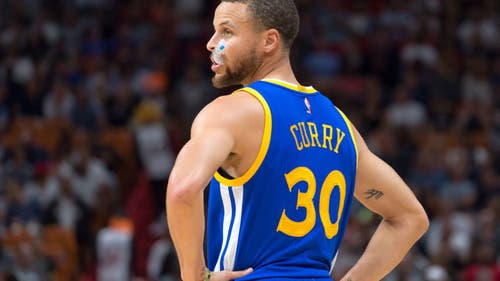
Suns and Warriors can't meet in Finals, and that's a shame
By Martin Rogers
FOX Sports Columnist
The NBA has two diamonds this season, a pair of teams that have lit up the campaign with their sustained excellence and built, in the process, a modern rivalry to behold.
The Phoenix Suns, blending the youthful excellence of Devin Booker, Deandre Ayton and Mikal Bridges with the evergreen leadership of Chris Paul, look unstoppable at times — and head into Friday night’s game against the New Orleans Pelicans with a record of 49-10.
The Golden State Warriors, charged as ever by Steph Curry’s shot-making ridiculousness and energized by the return of Klay Thompson, are ready for another title tilt and find themselves in no mood to make it easy for the upstarts from Arizona.
Yet the probability of the Suns and Warriors (43-17) meeting in the NBA Finals and putting together a showdown for the ages is precisely zero, a reality enforced by the way the league has long conducted its postseason formula.
Chris Broussard: Suns looked dominant
It is time for a change — the sooner, the better.
This isn’t a particularly novel or unique viewpoint. Calls for the Association to switch its current format — in which the top eight teams in each conference are seeded in opposing brackets regardless of overall record — have been around for years.
The noise rises with greater frequency whenever there is a significant imbalance between the East and West and when teams hovering at or below .500 sneak into the postseason and then perform poorly.
That’s one issue, and it is worthy, but the more pressing and consistent matter is a need to make it at least possible for the best two teams in the league to square off with the championship on the line.
We won’t get the dream matchup this year. We might see the Suns and Warriors do battle, but it would be in the Western Conference finals.
In truth, the best two teams hardly ever meet. The postseason is unpredictable enough that even with an amended 1-16 seeding pattern, the chances of the first two finishers from the regular season colliding in the Finals are statistically slim.
But doing it the way it has been done for so long, with a West bracket and an East bracket and the two survivors duking it out, makes it impossible in most years to get the optimum clash.
In five of the past six seasons, the teams with the two best regular-season records have been from the same conference. Barring a meltdown from the Warriors, it is going to happen again, even with the Chicago Bulls surging impressively on the eastern side of the country.
The NBA isn’t blind to this. Back in 2018, commissioner Adam Silver admitted that he would prefer a format in which "your best two teams are ultimately going to meet in the Finals."
During his address at the recent All-Star Weekend, Silver spelled out some of the issues involved.
"It’s something we have continued to look at," he told reporters. "The biggest issue isn’t tradition but the travel. When you start mapping out what it would mean in the playoffs for teams to be constantly crisscrossing the country, that’s worrisome to us.
"One of the things I’m always reading about is the potential for fast air travel. That may solve part of the problem. At least for now, we’re going to continue with the existing format."
However, there could be ways to meet in the middle. Right now, with the West markedly stronger, getting enough Eastern Conference owners to sign off on a tweak that could reduce their number of playoff spots would be a nonstarter. In that case, continue to send the top eight from each conference to the postseason, but seed them all based on record.
As for the travel, why not keep it in conference alignment for the first round — or even the first two — before lining the teams up based on how they performed during the year?
The travel impact would not be so significant in such an instance, especially when offset by the potential for reduced travel in the Finals, precisely the time when you’d want the best players to be as fresh as possible after a grueling season.
Daryl Morey, president of basketball operations for the Philadelphia 76ers, put forward some bold suggestions in a recent appearance on "The Colin Cowherd Podcast," advocating for a reduction in the number of regular and postseason games, a change that could go hand-in-hand with an alteration to the playoff seeding structure as part of limiting the travel demands on players.
"I like 58 [games]," Morey said, suggesting that each team would play each other twice. "The playoffs, I 100 percent agree, shorter is better. I would have it one-and-done. There’s a reason everyone tunes in to every game at huge ratings in the NFL. It is literally one-and-done."
A collection of television contracts that pull in vast sums of money in return for a glut of games likely makes that idea problematic, but Morey’s comments provide some valuable food for thought.
The NBA likes to innovate and will never be accused of standing still. The recently adopted play-in tournament has given the postseason extra edge, and there is ongoing chatter about a midseason tournament that would surely generate a lot of buzz.
But the postseason imbalance is one of the NBA's longest-standing problems, and it detracts from the overall product. The Suns and Warriors, with their excellence this season, are bringing that into sharper focus, with the knowledge that the optimum Finals showdown simply cannot come to pass.
Realistically, a change is long overdue.
Martin Rogers is a columnist for FOX Sports and the author of the FOX Sports Insider Newsletter. You can subscribe to the newsletter here.











